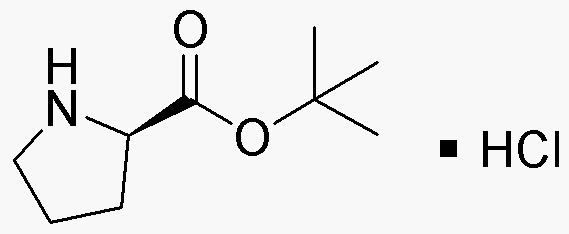D-Proline tert-butyl ester hydrochloride is widely utilized in research focused on:
- Peptide Synthesis: This compound serves as a valuable building block in the synthesis of peptides, particularly in creating cyclic peptides that are essential in drug development.
- Chiral Auxiliary: It acts as a chiral auxiliary in asymmetric synthesis, helping chemists produce enantiomerically pure compounds, which are crucial in pharmaceuticals.
- Biochemical Research: Researchers use it to study protein folding and stability, providing insights into diseases related to protein misfolding.
- Drug Development: Its role in modifying drug structures enhances bioavailability and efficacy, making it a key player in the pharmaceutical industry.
- Material Science: The compound is explored in the development of novel materials, including polymers that exhibit unique properties for various applications.
Informations générales
Propriétés
Sécurité et réglementation
Applications
D-Proline tert-butyl ester hydrochloride is widely utilized in research focused on:
- Peptide Synthesis: This compound serves as a valuable building block in the synthesis of peptides, particularly in creating cyclic peptides that are essential in drug development.
- Chiral Auxiliary: It acts as a chiral auxiliary in asymmetric synthesis, helping chemists produce enantiomerically pure compounds, which are crucial in pharmaceuticals.
- Biochemical Research: Researchers use it to study protein folding and stability, providing insights into diseases related to protein misfolding.
- Drug Development: Its role in modifying drug structures enhances bioavailability and efficacy, making it a key player in the pharmaceutical industry.
- Material Science: The compound is explored in the development of novel materials, including polymers that exhibit unique properties for various applications.
Documents
Fiches de données de sécurité (FDS)
La FDS fournit des informations de sécurité complètes sur la manipulation, le stockage et l’élimination du produit.
Spécifications du produit (PS)
Le PS fournit une description complète des propriétés du produit, notamment sa composition chimique, son état physique, sa pureté et les exigences de stockage. Il détaille également les plages de qualité acceptables et les applications prévues du produit.
Certificats d'analyse (COA)
Recherchez des certificats d'analyse (COA) en saisissant le numéro de lot du produit. Les numéros de lot et de lot se trouvent sur l'étiquette d'un produit, après les mots « Lot » ou « Lot de fabrication ».
Numéro de catalogue
Numéro de lot/série
Certificats d'origine (COO)
Ce certificat d'exploitation confirme le pays dans lequel le produit a été fabriqué, et détaille également les matériaux et composants utilisés et s'il est issu de sources naturelles, synthétiques ou autres sources spécifiques. Ce certificat peut être requis pour les douanes, le commerce et la conformité réglementaire.
Numéro de catalogue
Numéro de lot/série
Fiches de données de sécurité (FDS)
La FDS fournit des informations de sécurité complètes sur la manipulation, le stockage et l’élimination du produit.
DownloadSpécifications du produit (PS)
Le PS fournit une description complète des propriétés du produit, notamment sa composition chimique, son état physique, sa pureté et les exigences de stockage. Il détaille également les plages de qualité acceptables et les applications prévues du produit.
DownloadCertificats d'analyse (COA)
Recherchez des certificats d'analyse (COA) en saisissant le numéro de lot du produit. Les numéros de lot et de lot se trouvent sur l'étiquette d'un produit, après les mots « Lot » ou « Lot de fabrication ».
Numéro de catalogue
Numéro de lot/série
Certificats d'origine (COO)
Ce certificat d'exploitation confirme le pays dans lequel le produit a été fabriqué, et détaille également les matériaux et composants utilisés et s'il est issu de sources naturelles, synthétiques ou autres sources spécifiques. Ce certificat peut être requis pour les douanes, le commerce et la conformité réglementaire.

